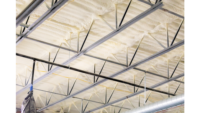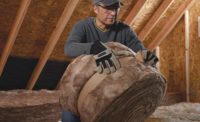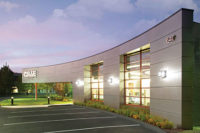Like never before, building owners demand that new and retrofitted buildings be as energy efficient as possible. There are many strategies on the market today that can be adopted to achieve these high performance buildings (i.e. building envelope, renewable energy, high efficient mechanical systems and etc.), however the most economical and logical method would be to utilize the passive building approach. The passive building approach has been derived from the well-known European Trias Energetica Concept, which promotes passive energy savings rather than energy savings from mechanical systems. The TEC’s principles and brief description are shown here.
- Reduce the Energy Demand—designing efficient building envelopes through the utilization of a highly effective thermal layer, high performance openings (doors and windows), orientation, shading, ventilation and etc.
- Use Sustainable Energy Sources—when you have achieved an optimal building envelope, then sustainable energy sources such as solar, wind and thermal can be used.
- Use Fossil Fuels Efficiently—if additional energy inputs are required, use only high efficient mechanical systems.
Though this approach has many variables associated with the concept, this article is going to touch upon how the thermal layer within the building envelope should be chosen to efficiently achieve the first tier of the Trias Energetica Concept—“Reduce the Energy Demand.” Additional information can be found at www.triasenergetica.com.
Like many other building components found on a typical construction site, thermal insulation can come in various shapes, colors, sizes, manufacturing process, and performance/mechanical properties, however, the number one question being asked is “What is its R value?” The specified and tested thermal insulation’s R value is only one aspect of the material’s properties and performance. Asking the question “What is its R value?” is similar to asking a car salesman “What is the vehicle’s horsepower?” and not having any other interest on the overall performance of the vehicle.
Thermally speaking, when deciding on which thermal insulation material should be used on a project, the designer should actually spend some time on this decision, as there are many other properties that can affect the building’s performance. Going back to a car analogy—would you be happy with a Lamborghini engine in a Ford Pinto? Some may, however the majority would want total performance over engine performance. Therefore, to assist designers in deciding which thermal insulation should be used for their projects, several major key criteria should be considered. These major key criteria are listed below.
When selecting high performance thermal insulation for a building envelope (i.e. walls, roofs, ceilings and etc.) the designer, at a minimum should consider these five key criteria:
- Stable R value (Aging)
- Dynamic R values (Temperature Dependent)
- Dimensional stability
- Product durability
- Breathability
The main focus of this article is to assist the designer with the key design criteria for energy efficient building envelope systems; however other important criteria not discussed but very much as important in this article are fire performance, acoustical performance, chemical composition and environmental concerns.
As mentioned previously in this article, there are many types of thermal insulation materials available on the market today. Depending on your local region some products may be more mainstream then others. In reference to the building envelope’s thermal efficiency, we are going to specifically discuss the properties and performance of three mainstream products on the market today. These three products being evaluated include extruded polystyrene insulation, polyisocyanurate insulation and mineral wool (stone wool).
STABLE R VALUE (AGING)
Thermal insulations obtain their R value by trapping still air or gas within a manufactured system or product. A basic example, mineral wool insulation (stone wool), uses finely spun non directional rock and slag fibers to trap still air within its boundaries, whereas extruded polystyrene and polyisocyanurate foam insulation uses trapped low thermally conductive blowing agents within its boundaries. Even though foam insulations use low thermal conductive blowing agents, the issue with using these gases in thermal insulations is that over time, the impregnated gas trapped within the boundaries of the foam product is replaced with air (rates are slower with a foil facing). This doesn’t mean that foam insulation loses all of its R value; it means that it could lose a certain percentage of R value throughout its service life.
If you refer to some of the major foam manufacturer’s warranties, you will discover that the reduction in R value could be between five and 20 percent in the first year of service. In practice, if a roofing product, polyisocyanurate, is calculated at R6 per inch, theoretically after the first year in service the polyisocyanurate could drop to R4.8 and still meet the manufactures warranty. This does not happen in mineral wool insulation due to the properties of air, however if convection occurs within the material (very low density batts) the R value can be diminished. Since buildings are built to be around for many years, it is imperative that materials in the thermal layer be used that can provide their effective R values for the life of the envelope.
DYNAMIC R VALUE
Thermal insulation materials in North America are required to state their R-values at 24 degrees Celsius (75 degrees Fahrenheit), which is for the most part irrelevant based on the fact that we do not need to insulate ourselves against room temperature. Traditionally, this 75 degrees F temperature has been used for practical testing purposes; however it does not provide an overall representation of the insulation’s performance within its regional climatic zone. Thermal insulation R values will perform differently whether it is in the Northern part of North America (cold climates) or the Southern part of North America (warm climates) therefore dynamic R values should be a part of design discussions regarding building performance.
Depending on the type of manufacturing process for the insulation, the R value has the potential to either increase or decrease when the temperature is below 75 degrees F and/or decrease when the temperature is above 75 degrees F. This phenomenon is due to the physics of heat transfer (convection, conduction and radiation) and the specific material properties. This article will not discuss heat transfer and the physics behind it at this point in time.
To assist the designer in choosing a high performance insulating materials, there are three figures shown in the charts supplied throughout this article demonstrating the impact of temperature on each material being compared. From the charts, you can see the polystyrene foam and mineral wool insulations have an increased R value performance at colder temperatures and the polyisocyanurate insulation has a decreased R value performance at colder temperatures. All materials compared, tend to have a decreased R value performance at elevated temperatures above 75 degrees F. This is not to say that one material is better than the other—it is just to point out that the designer must account for these known deficiencies.
Some designers have used a hybrid type approach (materials that increase in R value at colder temperatures on top of materials that decrease in R value at colder temperatures) successfully to ensure the thermal envelope specified is maintained. The hybrid system approach works because the material with the reduction in R value at colder temperatures is placed in a location where it can be thermally managed.
- Figure 1—BSC Info Sheet: Info-502: Temperature Dependence of R-values in Polyisocyanurate Roof Insulation. Additional information can be found at http://www.buildingscience.com/documents/information-sheets/info-502-temperature-dependent-r-value/
- Figure 2—National Roofing Contractors Association’s Technical Library: Testing Polystyrenes R-Values. Additional information can be found at http://docserver.nrca.net/technical/9629.pdf
- Figure 3—Temperature Dependence of R Value Mineral Wool Roof (TRDD+) Insulation compared to Polyisocyanurate: Third party testing was completed by BSC and TRDD+ was incorporated to show comparison between mineral wool and polyisocyanurate.
DIMENSIONAL STABILITY
Not only does temperature have an impact on the R value performance of thermal insulations, it also has a huge impact on the dimensional stability of material. Having a material that can expand and/or contract due to thermal cycling can potentially have negative impact on the building envelope’s performance such as increased heat flow, functionality, durability and etc. To maintain the building envelope’s thermal integrity from expansion and contraction, materials such as mineral wool can be utilized to minimize the potential for open gaps at lower temperatures. Foam insulations have a much higher coefficient of linear expansion (usually 10 times greater than steel); therefore treatment at the insulation’s joints should be required to minimize the potential for damage/durability issues as well as lowered thermal efficiency.
Studies from Oakridge National Laboratory in 2000 “Effects of Mechanical Fasteners and Gaps between Insulation Boards on Thermal Performance of Low Sloped Roofs” have demonstrated that 25 mm (1 inch) gaps between insulation boards in various climate zones can account for up to 15.3 percent to 15.9 percent increased heat flow. So if you do not want to pay an additional 15.3 to 15.9 percent in energy costs it is very important to minimize the potential for gaping in the building’s envelope. The ORNL study goes on to say that even when thermal insulation is layered in two lifts with staggered joints the difference between the single non-staggered joints are minimal. Movement towards hybrid systems (using low coefficients of linear expansion on top of high coefficients of linear expansion) has been seen in the industry to reduce the potential for gapping due to thermal cycling.
BREATHABILITY
Moisture damage is the number one issue for building envelope failure, so designing an envelope that can dry in both directions is ideal to enhancing the assembly’s durability. Using permeable materials throughout the building envelope will ensure that vapor drive or drying potential is not restricted, in any direction. No matter how well the assembly is constructed, water will eventually get in and having methods to deal with the vapor/moisture is essential.
There are several insulating foam materials that have low vapor permeance and when used in conjunction with a vapor retarder can create a double vapor retarder—and if water gets in, it cannot get out. When using storage or reservoir type claddings used with mineral wool insulation, it is important to understand how the drive of the inward vapors behave. Today, there are several tools (computer aided and manual calculations) on the market that are available to designers, which can assist them in determining materials that will minimize the potential for moisture related issues. The other option is to contact a building science specialist to consult on the related envelope design.
DURABILITY
It is imperative to design building envelopes and use materials that are durable and long lasting as possible since there are limitations and cost implications for repair/retrofit once the envelope is enclosed. To function and perform suitably insulation materials must withstand several damaging variables such as fire, ultraviolet rays, moisture, heat and wind damage to name a few should be closely examined. To maintain thermal efficiency, the material must not be susceptible to warping and should be able to keep its shape over time even when elevated thermal conditions exist. Stone wool, XPS and polyiso are all durable options, but their performance in each of the aforementioned categories can vary.
Determining the durability time frame for the thermal envelope and or materials within, one should review durability standards that identify typical service lives on standard building classifications and components. Another avenue to assist designers in calculating the service life of materials is to contact the manufacturer’s technical department for generic service life information.
CONCLUSION
Climates in North America can be hot, cold, mild, humid, dry, and wet—or some combination. Basic physics tells us that materials will expand/contract and/or increase/decrease in R value due to temperature fluctuations and the best option is to use an insulation material that will perform at its best given the anticipated conditions. Designing and utilizing hybrid type systems (best of both insulation materials) will ensure that the building envelope’s designed performance will be maintained. Materials that are manufactured with blowing agents must be carefully understood and designed, as the gases trapped have the potential to escape and be replaced with air (commonly known as aging), reducing the thermal efficiency. It is guaranteed that moisture will ingress into the buildings envelope and solutions to accommodate for the drying of these assemblies and components is crucial.
Buildings are built to be operational for many years, however using materials that may not meet the service life of the building may be expensive to remediate and even worse disrupt the operation of the building until remediation is complete. Insulation materials must resist fire, UV, heat, wind, warping and etc., to ensure that the building envelope meets it intended thermal and durable service function.
Overall performance of the building envelope is up to the designer and hopefully these designers have the tools in hand to ensure that these assemblies are being designed/built with the right criteria in mind. I trust this article has pointed out several key performance criteria on three of the mainstream insulation materials on the market today. The comparison within should provide some valuable information on how to choose thermal insulation that will meet the complicated and dynamic needs of the building envelope.









Report Abusive Comment